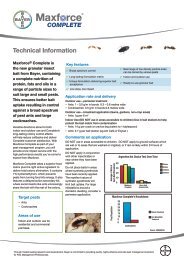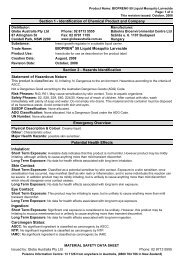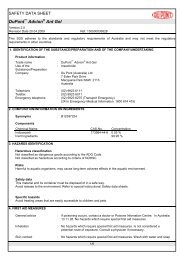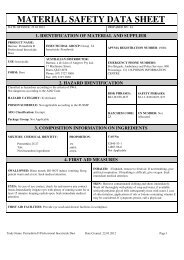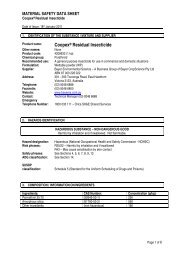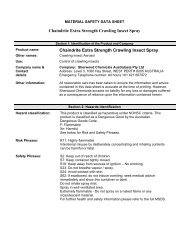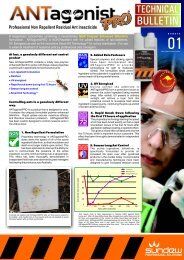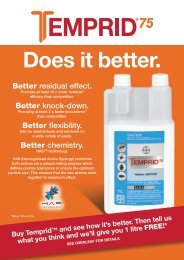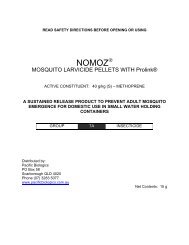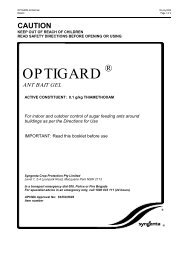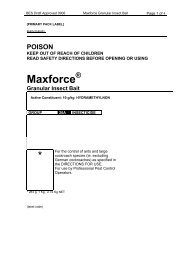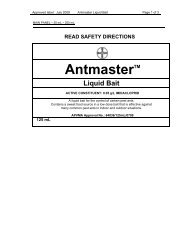MSDS - Rentokil Products
MSDS - Rentokil Products
MSDS - Rentokil Products
Create successful ePaper yourself
Turn your PDF publications into a flip-book with our unique Google optimized e-Paper software.
Product Name: <strong>Rentokil</strong> Alphachloralose Bird Control Agent<br />
Page: 1 of 5<br />
This version issued: February, 2009<br />
Section 1 - Identification Of Chemical Product And Company<br />
<strong>Rentokil</strong> Initial Pty Ltd<br />
Unit 1A, Lidcombe Business Park<br />
Lidcombe NSW 2141 ABN 98 000 034 597<br />
Substance:<br />
This is a sugar derivative.<br />
Trade Name:<br />
<strong>Rentokil</strong> Alphachloralose Bird Control Agent<br />
Product Code:<br />
40755 (APVMA code)<br />
Product Use:<br />
For the control of birds as directed on product label.<br />
Creation Date: February, 2004<br />
This version issued: February, 2009<br />
Section 2 - Hazards Identification<br />
Telephone (02)8719 6264<br />
Fax (02)8719 6124<br />
Emergency phone (02)8719 6264 (bus hours)<br />
Statement of Hazardous Nature<br />
This product is classified as: Hazardous according to the criteria of NOHSC Australia.<br />
Not a Dangerous Good according to the Australian Dangerous Goods (ADG) Code.<br />
Risk Phrases: R20/22. Harmful by inhalation and if swallowed.<br />
Safety Phrases: S20, S38. When using, do not eat or drink. In case of insufficient ventilation, wear suitable<br />
respiratory equipment.<br />
SUSDP Classification: S6<br />
ADG Classification: None allocated. Not a Dangerous Good.<br />
UN Number: None allocated<br />
Emergency Overview<br />
Physical Description & colour: White powdered solid.<br />
Odour: Faint odour.<br />
Major Health Hazards: harmful by inhalation and if swallowed.<br />
Potential Health Effects<br />
Acts as a narcotic. Symptoms of poisoning include effects on the nervous system and retardation of metabolism<br />
leading to initial stimulation incoordination, ataxia and sedation. Ingestion of large quantities may reduce body<br />
temperature to a fatal level.<br />
Inhalation<br />
Short term exposure: Significant inhalation exposure is considered to be unlikely. Long term inhalation of high<br />
amounts of any nuisance dust may overload lung clearance mechanism. Available data shows that this product is<br />
harmful, see below for symptoms of overexposure.<br />
Long Term exposure: No data for health effects associated with long term inhalation.<br />
Skin Contact:<br />
Short term exposure: Available data indicates that this product is not harmful. It should present no hazards in<br />
normal use. In addition product is unlikely to cause any discomfort in normal use.<br />
Long Term exposure: No data for health effects associated with long term skin exposure.<br />
Eye Contact:<br />
Short term exposure: Exposure via eyes is considered to be unlikely. This product is believed to be not irritating to<br />
eyes.<br />
Long Term exposure: No data for health effects associated with long term eye exposure.<br />
Ingestion:<br />
Short term exposure: Significant oral exposure is considered to be unlikely. Available data shows that this product<br />
is harmful. This product is unlikely to cause any irritation problems in the short or long term.<br />
Long Term exposure: No data for health effects associated with long term ingestion.<br />
Issued by: <strong>Rentokil</strong> Initial Pty Limited<br />
Product: <strong>Rentokil</strong> Alphachloralose Bird Control Agent<br />
Phone: (02)8719 6264 (bus hours) Page 1 of 5 Revised: February, 2009<br />
Poisons Information Centre: 13 1126 from anywhere in Australia, (0800 764 766 in New Zealand)
Product Name: <strong>Rentokil</strong> Alphachloralose Bird Control Agent<br />
Page: 2 of 5<br />
This version issued: February, 2009<br />
Carcinogen Status:<br />
NOHSC: No significant ingredient is classified as carcinogenic by NOHSC.<br />
NTP: No significant ingredient is classified as carcinogenic by NTP.<br />
IARC: No significant ingredient is classified as carcinogenic by IARC.<br />
Section 3 - Composition/Information on Ingredients<br />
Ingredients CAS No Conc,% TWA (mg/m 3 ) STEL (mg/m 3 )<br />
Alpha chloralose 15879-93-3 pure * not set not set<br />
* Commercially pure.<br />
This is a commercial product whose exact ratio of components may vary slightly. Minor quantities of other non<br />
hazardous ingredients are also possible.<br />
The TWA exposure value is the average airborne concentration of a particular substance when calculated over a normal 8 hour working day for a 5<br />
day working week. The STEL (Short Term Exposure Limit) is an exposure value that should not be exceeded for more than 15 minutes and should<br />
not be repeated for more than 4 times per day. There should be at least 60 minutes between successive exposures at the STEL. The term "peak "is<br />
used when the TWA limit, because of the rapid action of the substance, should never be exceeded, even briefly.<br />
Section 4 - First Aid Measures<br />
General Information:<br />
You should call The Poisons Information Centre if you feel that you may have been poisoned, burned or irritated by<br />
this product. The number is 13 1126 from anywhere in Australia (0800 764 766 in New Zealand) and is available at all<br />
times. Have this <strong>MSDS</strong> with you when you call.<br />
Inhalation: If symptoms of poisoning become evident, contact a Poisons Information Centre, or call a doctor at<br />
once. Remove source of contamination or move victim to fresh air. If breathing is difficult, oxygen may be beneficial if<br />
administered by trained personnel, preferably on a doctor's advice. DO NOT allow victim to move about<br />
unnecessarily. Symptoms of pulmonary oedema can be delayed up to 48 hours after exposure.<br />
Skin Contact: No specific health data is available for this product. If any unusual symptoms become evident, or if in<br />
doubt, contact a Poisons Information Centre or a doctor.<br />
Eye Contact: First aid is not generally required. If in doubt, contact a Poisons Information Centre or a doctor.<br />
Ingestion: If swallowed, do NOT induce vomiting. Wash mouth with water and contact a Poisons Information<br />
Centre, or call a doctor. Avoid giving alcohol.<br />
Section 5 - Fire Fighting Measures<br />
Fire and Explosion Hazards: There is no risk of an explosion from this product under normal circumstances if it is<br />
involved in a fire. This product, if scattered, may form flammable or explosive dust clouds in air.<br />
Fire decomposition products from this product may be toxic if inhaled. Take appropriate protective measures.<br />
Extinguishing Media: Preferred extinguishing media are carbon dioxide, dry chemical, foam, water fog.<br />
Fire Fighting: If a significant quantity of this product is involved in a fire, call the fire brigade. Do not scatter spilled<br />
material with high pressure water jets.<br />
Flash point:<br />
Not flammable.<br />
Upper Flammability Limit: No data.<br />
Lower Flammability Limit: No data.<br />
Autoignition temperature: No data.<br />
Flammability Class: No data.<br />
Section 6 - Accidental Release Measures<br />
Accidental release: In the event of a major spill, prevent spillage from entering drains or water courses. Evacuate<br />
the spill area and deny entry to unnecessary and unprotected personnel. Wear full protective clothing including<br />
eye/face protection. All skin areas should be covered. See above under Personal Protection regarding Australian<br />
Standards relating to personal protective equipment. Suitable materials for protective clothing include rubber, PVC.<br />
Eye/face protective equipment should comprise as a minimum, protective goggles. If there is a significant chance that<br />
dusts are likely to build up in cleanup area, we recommend that you use a suitable Dust Mask.<br />
Stop leak if safe to do so, and contain spill. Sweep up and shovel or collect recoverable product into labelled<br />
containers for recycling or salvage, and dispose of promptly. Consider vacuuming if appropriate. Recycle containers<br />
wherever possible after careful cleaning. Refer to product label for specific instructions. After spills, wash area<br />
preventing runoff from entering drains. If a significant quantity of material enters drains, advise emergency services.<br />
This material may be suitable for approved landfill. Ensure legality of disposal by consulting regulations prior to<br />
Issued by: <strong>Rentokil</strong> Initial Pty Limited<br />
Product: <strong>Rentokil</strong> Alphachloralose Bird Control Agent<br />
Phone: (02)8719 6264 (bus hours) Page 2 of 5 Revised: February, 2009<br />
Poisons Information Centre: 13 1126 from anywhere in Australia, (0800 764 766 in New Zealand)
Product Name: <strong>Rentokil</strong> Alphachloralose Bird Control Agent<br />
Page: 3 of 5<br />
This version issued: February, 2009<br />
disposal. Thoroughly launder protective clothing before storage or re-use. Advise laundry of nature of contamination<br />
when sending contaminated clothing to laundry.<br />
Section 7 - Handling and Storage<br />
Handling: Keep exposure to this product to a minimum, and minimise the quantities kept in work areas. Check<br />
Section 8 of this <strong>MSDS</strong> for details of personal protective measures, and make sure that those measures are followed.<br />
The measures detailed below under "Storage" should be followed during handling in order to minimise risks to<br />
persons using the product in the workplace. Also, avoid contact or contamination of product with incompatible<br />
materials listed in Section 10.<br />
Storage: This product is a Scheduled Poison. Observe all relevant regulations regarding sale, transport and storage<br />
of this class of poison. Store in the closed original container in a dry, cool, well-ventilated area out of direct sunlight.<br />
Make sure that the product does not come into contact with substances listed under "Materials to avoid" in Section 10.<br />
Check packaging - there may be further storage instructions on the label.<br />
Section 8 - Exposure Controls and Personal Protection<br />
The following Australian Standards will provide general advice regarding safety clothing and equipment:<br />
Respiratory equipment: AS/NZS 1715, Protective Gloves: AS 2161, Industrial Clothing: AS2919, Industrial Eye<br />
Protection: AS1336 and AS/NZS 1337, Occupational Protective Footwear: AS/NZS2210.<br />
ASCC Exposure Limits TWA (mg/m 3 ) STEL (mg/m 3 )<br />
Exposure limits have not been established by NOHSC for this product.<br />
Ventilation: No special ventilation requirements are normally necessary for this product. However make sure that<br />
the work environment remains clean and that dusts are minimised.<br />
Eye Protection: Eye protection is not normally necessary when this product is being used. However, if in doubt,<br />
wear suitable protective glasses or goggles.<br />
Skin Protection: The information at hand indicates that this product is not harmful and that normally no special skin<br />
protection is necessary. However, we suggest that you routinely avoid contact with all chemical products and that you<br />
wear suitable gloves (preferably elbow-length) when handling this product.<br />
Protective Material Types: We suggest that protective clothing be made from the following materials: rubber,<br />
PVC.<br />
Respirator: If there is a significant chance that dusts are likely to build up in the area where this product is being<br />
used, we recommend that you use a suitable Dust Mask. Use a P1 mask, designed for use against mechanically<br />
generated particles eg silica & asbestos.<br />
Section 9 - Physical and Chemical Properties:<br />
Physical Description & colour: White powdered solid.<br />
Odour:<br />
Faint odour.<br />
Boiling Point:<br />
Not applicable.<br />
Freezing/Melting Point: Decomposes before melting.<br />
Volatiles:<br />
No specific data. Expected to be low at 100°C.<br />
Vapour Pressure:<br />
No data.<br />
Vapour Density:<br />
No data.<br />
Specific Gravity: Approx 0.5<br />
Water Solubility:<br />
Slightly soluble - 0.45g/100mL water at 15°C.<br />
pH:<br />
No data.<br />
Volatility:<br />
No data.<br />
Odour Threshold:<br />
No data.<br />
Evaporation Rate:<br />
No data.<br />
Coeff Oil/water distribution: No data<br />
Autoignition temp:<br />
No data.<br />
Section 10 - Stability and Reactivity<br />
Reactivity: This product is unlikely to react or decompose under normal storage conditions. However, if you have<br />
any doubts, contact the supplier for advice on shelf life properties.<br />
Conditions to Avoid: Store in the closed original container in a dry, cool, well-ventilated area out of direct sunlight.<br />
Incompatibilities: strong acids, strong bases, strong oxidising agents.<br />
Fire Decomposition: Carbon dioxide, and if combustion is incomplete, carbon monoxide and smoke. Hydrogen<br />
chloride gas, other compounds of chlorine. Water. Carbon monoxide poisoning produces headache, weakness,<br />
Issued by: <strong>Rentokil</strong> Initial Pty Limited<br />
Product: <strong>Rentokil</strong> Alphachloralose Bird Control Agent<br />
Phone: (02)8719 6264 (bus hours) Page 3 of 5 Revised: February, 2009<br />
Poisons Information Centre: 13 1126 from anywhere in Australia, (0800 764 766 in New Zealand)
Product Name: <strong>Rentokil</strong> Alphachloralose Bird Control Agent<br />
Page: 4 of 5<br />
This version issued: February, 2009<br />
nausea, dizziness, confusion, dimness of vision, disturbance of judgment, and unconsciousness followed by coma<br />
and death.<br />
Polymerisation: This product is unlikely to undergo polymerisation processes.<br />
Section 11 - Toxicological Information<br />
Local Effects:<br />
Target Organs:<br />
Ingredient<br />
Alpha chloralose: LD 50 Oral, Rat 400mg/kg<br />
There is no data to hand indicating any particular target organs.<br />
Classification of Hazardous Ingredients<br />
Risk Phrases<br />
LD 50 Oral, Mouse = 32mg/kg<br />
Section 12 - Ecological Information<br />
This product is biodegradable. It will not accumulate in the soil or water or cause long term environmental problems.<br />
Section 13 - Disposal Considerations<br />
Disposal: Containers should be emptied as completely as practical before disposal. If possible, recycle containers<br />
either in-house or send to recycle company. If this is not practical, send to a commercial waste disposal site. This<br />
product should be suitable for landfill. However, check with local Waste Disposal Authority before sending there. Note<br />
that product properties may have been changed in use, significantly altering it's suitability for landfill. Please do NOT<br />
dispose into sewers or waterways.<br />
Section 14 - Transport Information<br />
ADG Code: This product is not classified as a Dangerous Good. No special transport conditions are necessary<br />
unless required by other regulations.<br />
Section 15 - Regulatory Information<br />
AICS: This product was found in the public AICS Database.<br />
The following ingredients: alpha chloralose is mentioned in the SUSDP.<br />
Section 16 - Other Information<br />
Acronyms:<br />
ADG Code<br />
AICS<br />
CAS number<br />
IARC<br />
ASCC<br />
NOS<br />
NTP<br />
R-Phrase<br />
SUSDP<br />
UN Number<br />
This <strong>MSDS</strong> contains only safety-related information. For other data see product literature.<br />
Australian Code for the Transport of Dangerous Goods by Road and Rail, 7th Edition<br />
Australian Inventory of Chemical Substances<br />
Chemical Abstracts Service Registry Number<br />
International Agency for Research on Cancer<br />
Office of the Australian Safety and Compensation Council<br />
Not otherwise specified<br />
National Toxicology Program (USA)<br />
Risk Phrase<br />
Standard for the Uniform Scheduling of Drugs & Poisons<br />
United Nations Number<br />
THIS <strong>MSDS</strong> SUMMARISES OUR BEST KNOWLEDGE OF THE HEALTH AND SAFETY HAZARD INFORMATION OF THE PRODUCT AND<br />
HOW TO SAFELY HANDLE AND USE THE PRODUCT IN THE WORKPLACE. EACH USER MUST REVIEW THIS <strong>MSDS</strong> IN THE CONTEXT OF<br />
HOW THE PRODUCT WILL BE HANDLED AND USED IN THE WORKPLACE.<br />
IF CLARIFICATION OR FURTHER INFORMATION IS NEEDED TO ENSURE THAT AN APPROPRIATE RISK ASSESSMENT CAN BE MADE,<br />
THE USER SHOULD CONTACT THIS COMPANY SO WE CAN ATTEMPT TO OBTAIN ADDITIONAL INFORMATION FROM OUR SUPPLIERS<br />
OUR RESPONSIBILITY FOR PRODUCTS SOLD IS SUBJECT TO OUR STANDARD TERMS AND CONDITIONS, A COPY OF WHICH IS SENT<br />
TO OUR CUSTOMERS AND IS ALSO AVAILABLE ON REQUEST.<br />
Please read all labels carefully before using product.<br />
This <strong>MSDS</strong> is prepared in accord with the NOHSC document “National Code of Practice for the Preparation of<br />
Material Safety Data Sheets” 2nd Edition [NOHSC:2011(2003)]<br />
Copyright © Kilford & Kilford Pty Ltd, February, 2009.<br />
Issued by: <strong>Rentokil</strong> Initial Pty Limited<br />
Product: <strong>Rentokil</strong> Alphachloralose Bird Control Agent<br />
Phone: (02)8719 6264 (bus hours) Page 4 of 5 Revised: February, 2009<br />
Poisons Information Centre: 13 1126 from anywhere in Australia, (0800 764 766 in New Zealand)
Product Name: <strong>Rentokil</strong> Alphachloralose Bird Control Agent<br />
Page: 5 of 5<br />
This version issued: February, 2009<br />
http://www.kilford.com.au/ Phone (02)9251 4532<br />
Issued by: <strong>Rentokil</strong> Initial Pty Limited<br />
Product: <strong>Rentokil</strong> Alphachloralose Bird Control Agent<br />
Phone: (02)8719 6264 (bus hours) Page 5 of 5 Revised: February, 2009<br />
Poisons Information Centre: 13 1126 from anywhere in Australia, (0800 764 766 in New Zealand)



